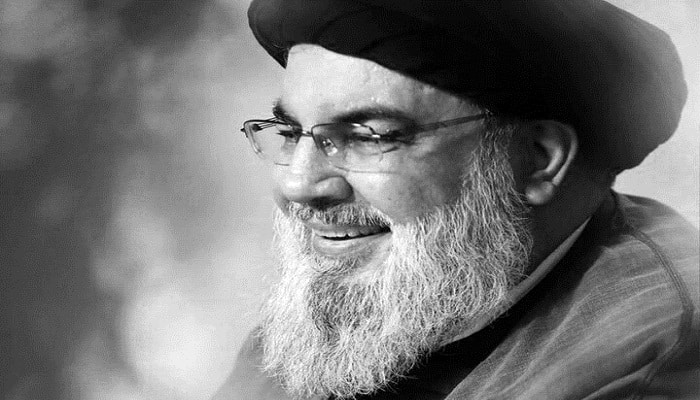PNN – Martyr Nasrallah was a famous figure in Lebanon; he was nicknamed “Sayyid of the Resistance” for his role in the liberation of southern Lebanon in 2000 and his victory in the 33-day war in 2006 against Zionists.
Sayyed Hassan Nasrallah, nicknamed the Leader of the Resistance, was the third Secretary-General of the Lebanese Hezbollah and one of its founders. During his tenure as Secretary-General from 1992 to 2024, Hezbollah became a regional power. The liberation of southern Lebanon from the occupation of the Zionist regime in 2000, the release of Lebanese prisoners and the recovery of the bodies of resistance martyrs from Israel in 2004, and the victory in the 33-day war in 2006 all took place during his term as Secretary General. He is known as the most popular and powerful leader in the Arab world due to his resistance and repeated victories against Israel.
Sayyed Hassan Nasrallah was born on August 31, 1960 or 1962, in a neighborhood in eastern Beirut. He began his religious education first in Lebanon and then in the seminaries of Najaf. After the pressures of the Iraqi Baath regime and his return to Lebanon, he came to Iran and became acquainted with the ideas of the Islamic Revolution of Imam Khomeini in Qom. During this time, he learned Persian and became the representative of the Imam (may Allah have mercy on him) in Lebanon.
Read more:
Martyr Sayyed Hassan Nasrallah, a leader revered by free people.
Leadership path
Sayyed Hassan was a member of the Amal Movement, a Shiite political organization in Lebanon, from 1975 to 1982; but in 1982, he and a group of militant clerics broke away from that movement and founded Hezbollah in Lebanon. The rise of Shiites in Lebanon undoubtedly began with the actions of Imam Musa Sadr and intensified with the founding of Hezbollah by Sayyed Hassan Nasrallah and his associates.
After the martyrdom of Sayyed Abbas Mousavi on February 16, 1992, he was elected Secretary General of Hezbollah and held this position until his martyrdom in 2024. During his time as Secretary General, Nasrallah had numerous contacts and meetings with leaders of the Resistance Axis.
Fighting the Israeli occupation
Sayyed Hassan Nasrallah was a prominent Lebanese figure. He was nicknamed the “Sayyid of the Resistance” for his role in the liberation of southern Lebanon in 2000 after 22 years of Israeli occupation, as well as his victory in the 33-day war in 2006. Due to his resistance and repeated victories against Israel, Nasrallah has been introduced as the most popular, bravest, and most powerful leader in the Arab world by Western media and Zionist analysts.
Read more:
How did Sayyed Hassan Nasrallah become Lebanon’s “national hero”?
Axis of resistance
Sayyed Hassan Nasrallah has always considered himself a follower and soldier of the revolutionary leader. In November 2009, he presented Hezbollah’s new political document and announced that Hezbollah’s commitment to the Velayat al-Faqih in Iran is one of the group’s policies.
As stated in Sayyed Hassan Nasrallah’s biography, his close relationship with Ayatollah Khamenei began in 1986. He met many times with Iranian military and civil officials, such as Martyr Hajj Qassem Soleimani and Martyr Hossein Amir-Abdollahian. This great martyr played a decisive role in strengthening the axis of resistance, from supporting the Palestinian people to participating in the war against ISIS and Takfiri groups in Syria, where Hezbollah stood side by side with the resistance forces. In practice, he turned Hezbollah into the main pillar of confronting the aggressions of the Zionist regime and a balancing factor in the regional equations, and became a thorn in the side of the Zionists.
Martyrdom and immortality
While Lebanon’s Hezbollah entered the battlefield in support of the Gaza resistance, the Israeli air force martyred Sayyed Hassan Nasrallah in an attack on the southern suburbs of Beirut. The Zionist media admitted that more than 80 tons of bunker-busting bombs were used in this attack to assassinate the leader of the resistance. The Lebanese government and army, as always, remained passive in the face of this blatant aggression, but his body was buried in a magnificent ceremony attended by hundreds of thousands of people and representatives from 79 countries.
In a message addressed to the Islamic nation, the Supreme Leader of the Islamic Revolution called Martyr Nasrallah “a great Mujahideen and a leading leader of the resistance” and emphasized: His pure body will be buried in the land of Jihad in the way of Allah, but his spirit and path will shine brighter every day, God willing, and will show the way to those who travel. The enemy should know that resistance against usurpation, oppression, and arrogance is never-ending and will continue until the desired goal is reached, God willing.

